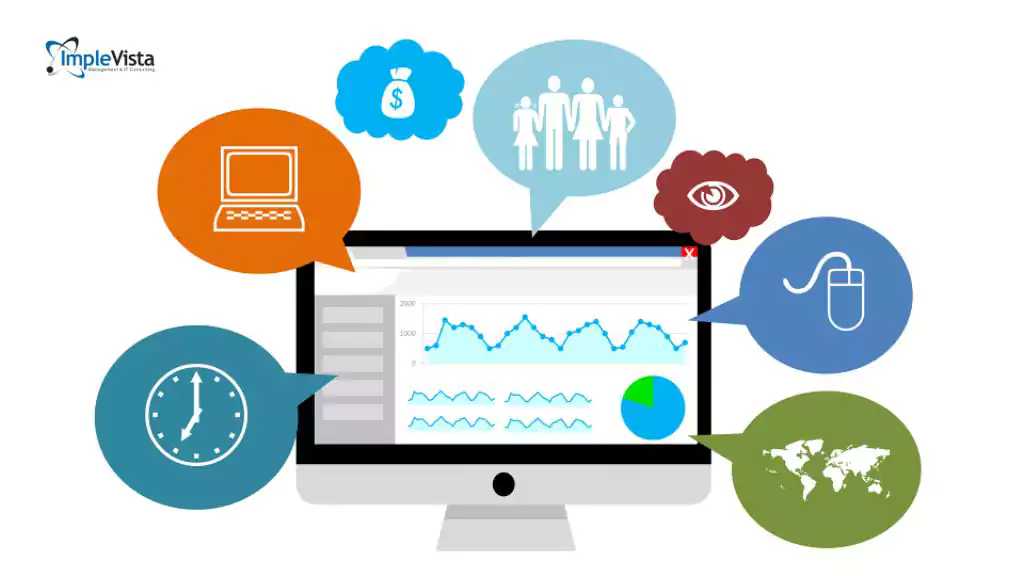Interactive content – quizzes, polls, calculators, infographics and more – flips the traditional passive approach on its head, turning audiences into active participants. By encouraging users to click, answer, and explore, interactive formats captivate attention and deliver value. In fact, interactive content generates about 52.6% higher engagement than static content and can extend time on site by up to 50%.
For example, a travel booking app featuring a flight-search quiz or a “destination discovery” tool (illustrated below) can draw visitors in deeper. This engagement gives users a sense of fun and personalization while gathering valuable data about their preferences. As Implevista’s experts note, employing “interactive tools such as quizzes and calculators” is key to keeping audiences interested.
Interactive formats aren’t just entertaining – they provide real value. They let users get personalized feedback (a quiz tells them something about themselves), gauge opinions (a poll shows what peers think), or solve problems (a calculator outputs personalized results). This dynamic experience makes content “feel more real and relevant,” deepening engagement.
Brands like Sephora and IKEA have even used augmented reality (AR) quizzes and calculators to boost click-through rates and conversions. In the digital world, giving users a reason to click around turns them from passive browsers into invested participants. Ultimately, interactive content marketing means weaving these engaging elements into your content engagement strategy, so each visit becomes a memorable, data-rich interaction.
What is Interactive Content Marketing?
Interactive content marketing means using content that invites user participation rather than one-way viewing. In contrast to “static” content (like plain articles or images), interactive content requires audience input – think quizzes, polls, games, and calculators. When readers must click, answer questions, or enter information, they engage actively.
It’s like hosting a conversation instead of lecturing. Interactive content is often called dynamic content because it changes based on user actions. For instance, an online quiz might branch to different outcomes based on answers, or an interactive infographic might let users click for more details.
This hands-on approach not only entertains but educates and personalizes. It makes marketing feel like a two-way dialogue: users feel involved, and brands gain insights. As one guide explains, interactive content “can be responsive to the actions of that user” and is “a lot more engaging and personalized” than static content.
In practice, interactive content marketing could involve embedding a poll in a blog post, using a calculator in a whitepaper, or adding quizzes to social campaigns.
Why Interactive Content Boosts Engagement
Interactive content is proven to supercharge engagement. Numerous studies confirm what marketers observe: people spend more time and show more interest in content they can manipulate. For example, when users interact with content, they average around 13 minutes on a page, versus only 8–9 minutes for non-interactive content.
That’s because clicking through quizzes, dragging sliders, or exploring interactive graphs makes the experience more engaging. Statistically, interactive pieces deliver dramatically higher metrics. One analysis found that interactive content “sees 52.6% higher engagement than static content”. Another report shows interactive content typically generates twice as much engagement as passive content.
Social posts with interactive elements get far more shares and comments than plain posts. This surge in interest is partly because active formats are novel and fun – they reward attention with a personalized result or surprise. Brands that incorporate interactive elements also report big wins in conversions and loyalty. According to industry surveys, interactive content can convert buyers roughly 70% of the time – nearly double the rate for passive content.
By demanding active participation, interactive tools naturally qualify interest: a user who completes a quiz or calculator is signaling stronger intent. This makes it easier for marketers to capture leads and nurture prospects. In short, interactive content invites engagement rather than hoping for it.
This approach also ties into SEO and UX goals. Interactive experiences keep visitors on the page longer and reduce bounce rates, sending positive signals to search engines. When content resonates more (likes, shares, dwell time), it tends to rank higher. As one marketer notes, interactive content “keeps readers glued to the page… signaling to search engines that your content is valuable”. In other words, when users stick around to play or answer a poll, Google takes notice.
Popular Interactive Content Formats
Interactive content comes in many shapes. The most effective formats each combine engagement with usefulness. Here are some top examples:
- Quizzes and Assessments. Fun, often personalized quizzes (e.g. “Which product fits your style?”) are huge for engagement. They can help users learn something about themselves and quickly deliver tailored advice. BuzzFeed’s millions of quiz-driven visits are a testament: quizzes can become viral and pull in huge audiences. Quizzes work because they’re shareable and give instant feedback. They also naturally collect data when users submit their answers.
- Polls and Surveys. One-question polls or short surveys let people weigh in immediately. They’re quick to complete and can be social (users like seeing poll results). Polls are like tiny dialogues – answering one question makes users feel heard. Importantly, polls also gather insights: each vote or survey response provides feedback on preferences. As one example, Taco Bell’s app poll asking customers to vote on menu items drew nearly a million responses – a massive engagement that even influenced product decisions.
- Interactive Infographics. These are graphics where parts are clickable or animated. Instead of a static chart, imagine an infographic where clicking reveals deeper data or animations. For example, a map infographic might let users click regions to learn more stats. According to Content Marketing Institute data, interactive infographics can increase user engagement by up to 45% over static visuals. The novelty of clicking through an infographic keeps readers exploring longer.
- Calculators and Tools. Dynamic tools like cost calculators, ROI calculators, or quizzes with number inputs give real practical value. Users input their own numbers and instantly get a customized result. For instance, a mortgage calculator or ROI estimator is extremely useful for users, and in return they’re happy to engage. Banks and finance blogs often embed calculators, and other industries use them too – from fitness apps (BMI calculators) to home improvement sites (cost estimators). Calculators are “the ultimate power move for adding real, practical value”. They turn content from theoretical into hands-on advice, making visitors much more likely to return.
- Interactive Videos and Content Experiences. These include videos or articles that branch based on viewer choices, 360° tours, and AR experiences. For example, a virtual property tour on a real estate site, or a “choose your own adventure” video ad. Though more complex to create, they deeply immerse users. Platforms like Facebook Instant Experiences are used by brands to craft such interactive narratives.
Each format shares a trait: it asks something of the user. That call-and-response draws people in.
Generating Leads and Capturing Data
A big advantage of interactive content is its lead-generation power. Users are much more willing to exchange contact info for valuable interactive experiences than for static whitepapers. Since quizzes and calculators inherently give something back, visitors feel the trade is fair. For example, an assessment that promises a personalized result (e.g. “Your Marketing Strategy Score”) often asks for an email before revealing the full report. Users don’t mind because they know they’ll get useful feedback.
Tools like calculators, polls and surveys “offer real value to users, and they are more willing to give up their contact information if they receive something in return”. In practice, interactive elements can be gated for lead capture – e.g. “Enter your email to see your quiz result” – or simply built into landing pages that convert. According to a marketing report, 85% of marketers use interactive content to gather customer data.
This data collection is not just for emails. Every click, answer or input tells you about user preferences. If many users choose “Option A” in a quiz, you learn what content to show next; if an interactive infographic is mostly explored by one demographic, you know where to focus advertising. As one expert notes, interactive content is a “gold mine of consumer data” providing insights into engagement patterns.
Moreover, interactive content can accelerate the buyer journey. A quiz that asks about needs (“Find your ideal product”) can quickly direct a user to the best solution, cutting through indecision. Poll results showing popular products can influence undecided buyers by social proof. All this translates into more qualified leads and higher conversions. One study even found that brands using interactive content see up to double the conversion rates compared to static approaches.
By integrating interactive elements, marketers turn passive pageviews into data-driven touchpoints. This not only fuels smarter follow-up (personalized emails, retargeted ads) but also helps refine the content engagement strategy over time.
Implementing Interactive Content in Your Strategy
To make the most of interactive content, blend it naturally into your content calendar. Start with a clear goal: do you want to educate, entertain, or qualify leads? Then choose a format accordingly. For example, if educating, a dynamic infographic or quiz can break complex info into engaging steps. If lead generation, an ROI calculator or assessment works great.
Best practices include:
- Align with audience interests. The topic must matter to users. A travel site might use “What’s your ideal vacation quiz,” while a B2B SaaS firm might offer a “Digital Maturity Calculator.” Make sure the interactive element feels useful, not gimmicky.
- Keep it concise. Quizzes should be quick (5–7 questions), and forms should be short. Users often abandon long interactions. The goal is immediate feedback, so simplify questions and steps.
- Integrate with campaigns. Promote your interactive content in emails, social posts, and ads. A quiz can be a fun lead magnet in a Facebook campaign, or a LinkedIn poll can tease a bigger survey.
- Mobile optimization. Ensure the experience is mobile-friendly. Many users may take quizzes or swipe through infographics on their phone. Responsive design is key.
- Measure and iterate. Track how users interact: completion rate, time spent, and conversion after interaction. Use analytics to see which formats perform best. Continuous A/B testing (e.g. quiz topic, button text) can improve results. As one content strategist notes, interactive content is a “must-have tool” whose success can be measured through the depth of user actions.
Examples in action: Imagine a tourism website using an interactive quiz “Which Bangladesh destination suits your travel style?” to warm up leads – every quiz submitter gets an email follow-up with itinerary suggestions. Or a B2B marketing firm might embed a marketing budget calculator designed by Implevista’s Content Marketing team on its site to capture client data.
Even social media channels embrace interactivity: Instagram Stories polls and Twitter polls instantly engage followers. Embedding these results back into your site or content keeps users connected across channels.
Case Study: Interactive Content in Tourism
Industries like travel and tourism see great benefits from interactive content. For example, digital campaigns for Bangladesh’s tourism often include virtual tours and fun quizzes to spark wanderlust. According to a Digital Implevista guide, “Interactive content like polls, quizzes, and virtual tours can engage users and drive bookings.”.
A travel blog might embed an interactive map of Cox’s Bazar beaches or a “Choose Your Adventure” video series. These formats not only entertain but help travel businesses collect preferences (e.g. which excursion a user likes most).
In practice, a tourism website could invite visitors to take a quick survey on their dream vacation. Each response not only boosts engagement but provides leads to follow up with personalized offers. By combining beautiful imagery with interactive widgets (e.g. a Phuket “Weather at a Glance” infographic that updates by city selection), travel brands keep visitors exploring longer, making their campaigns more memorable.
The ivTrip travel software Implevista’s travel agency platform also underscores this approach. Its interface examples (see above) show how integrating interactive search and booking tools creates a seamless user experience. When travel agencies use ivTrip’s booking engine with live flight and hotel search, they’re essentially providing an interactive content experience that directly leads to conversions. Embedding quizzes or recommendations within such platforms can turn curious browsers into paying customers.
Measuring Success and Long-Term Value
Because interactive content actively engages users, it pays off in clear metrics. Track metrics such as:
- Time on Page and Engagement Rate. Interactive pages typically show much higher dwell time. If a quiz takes 3 minutes to complete vs. a static page with 1-minute average time, that’s a major win.
- Conversion and Lead Quality. Are users who complete interactive experiences more likely to become customers? Measure form submissions or sign-ups post-interaction. Marketers often see higher conversion (even double) from users who interacted.
- Social Shares and Virality. Especially with quizzes or assessments, track how often users share your content. A well-designed quiz can spread organically on social media, amplifying reach for free.
- SEO Performance. Over time, pages with engaging content (lower bounce, higher time on site) tend to rank better. As Contently notes, keeping readers “glued to the page” improves SEO by signaling content quality.
Interactive content also boosts brand affinity. In surveys, about 81% of marketers say that engaging formats (quizzes, polls, calculators) are more effective at grabbing attention and driving loyalty than static posts. They create “memorable, interactive moments” that people associate with your brand.
For ongoing strategy, rotate in new interactive pieces and update evergreen ones. For instance, a calculator might need new data yearly, or a quiz can be themed around seasonal topics. By refreshing interactive content, you keep it relevant and maintain that high level of user interest.
Conclusion
Interactive content marketing is not just a trend—it’s a proven method to amplify engagement and capture leads. Formats like quizzes, polls, calculators and interactive infographics do more than entertain: they give real value to users and keep them on your site longer. By incorporating these tools into your campaigns, you create memorable experiences that strengthen brand loyalty and fuel your content engagement strategy.
Is your marketing ready to go beyond static posts? Partner with Implevista Digital Marketing to craft interactive campaigns that stand out. Explore our Content Marketing services to see how we integrate quizzes and calculators into a winning strategy. Check out insights on our blog for more tips, or contact us for a tailored plan. Let’s make your content work harder – engaging audiences and turning clicks into customers.
Get Started: Visit our digital marketing services or contact Implevista Digital to take your campaigns to the next level.
FAQs about Interactive Content Marketing
Q: What is interactive content marketing?
A: It’s using content formats that require user interaction (instead of just reading) – like quizzes, polls, assessments, calculators, interactive infographics, and more. These formats engage audiences by inviting them to participate. Unlike static articles or images, interactive content turns passive viewing into a two-way experience.
Q: How do quizzes and polls boost engagement?
A: Quizzes and polls get people involved. A quiz entertains and often provides personalized feedback (which users share on social media), while a poll asks for opinions and shows community results. Because users actively answer questions, they spend more time on your page and feel a deeper connection. For example, a quick “Personality Quiz” can turn casual visitors into engaged users eager to see their result.
Q: Why is interactive content good for SEO and retention?
A: Interactive formats increase time on page and lower bounce rates, signaling search engines that content is valuable. When people stick around to explore an infographic or complete a survey, search engines take notice. Better engagement metrics (like longer session duration) can improve search rankings, driving more organic traffic to your site.
Q: Can interactive content really generate leads?
A: Yes. Since interactive elements give something in return (fun or useful info), users are often happy to submit their email or contact info. For example, users might share their email to get a quiz result or download an in-depth report after answering a survey. This way, your content becomes a lead magnet. Studies show interactive content significantly increases lead capture compared to static downloads.
Q: What types of interactive content work best for lead gen?
A: Tools that provide immediate value tend to work well: calculators (e.g. ROI or budget estimators), quizzes, and surveys. These can be gated behind forms or integrated into landing pages. Content like interactive infographics (where users can also submit questions) and polls on websites/social media can also double as data collection tools, prompting users to opt-in for more results or insights.
Q: How do I measure the success of interactive content?
A: Key metrics include engagement rate (time spent, completion rate), shares/feedback, and conversion rate. Compare how long users stay on interactive pages versus static ones, and track how many leads (sign-ups or inquiries) originate from those pages. You should also monitor social shares and comments. Most importantly, measure whether interactive campaigns improve overall engagement: for example, see if your average session duration or pages per visit increase after rolling out new interactive pieces.
Q: Do small businesses benefit from interactive content?
A: Absolutely. Interactive content isn’t only for large brands. In fact, for smaller businesses, it’s a cost-effective way to stand out. Even a simple quiz or poll on a blog can engage local audiences. Creative quizzes or calculators tailored to your niche can help you compete with bigger players by offering personalized value. According to experts, interactive marketing “levels the playing field,” since you engage consumers in a unique way regardless of company size.
Q: How can we align interactive content with our content engagement strategy?
A: First, identify your goals (brand awareness, lead gen, education) and audience interests. Then choose the right format – for example, use a poll to gather opinions or a quiz for product recommendations. Integrate interactive elements into your content calendar (like publishing one quiz or survey per month) and promote them across channels. The key is to make the interactive piece consistent with your brand voice and useful for the user. Over time, interactive assets become signature elements of your engagement strategy that keep audiences coming back.
Q: What’s the difference between interactive and static content?
A: Static content (blog posts, infographics, videos) is one-way: the audience just reads or watches it. Interactive content requires action from the user. For example, a static infographic shows information, but an interactive infographic might let users click sections to explore deeper layers. This interactivity demands attention and participation, making the content more engaging. Studies show interactive content gets 50–52.6% more engagement than static material.
Q: Is interactive content worth the extra effort?
A: Yes. While interactive assets often take more development time, their impact can be significant. They not only engage audiences but also provide data and foster loyalty. Users often remember interactive experiences better, and marketers report higher ROI from interactive campaigns. In the long run, interactive content can make your marketing more effective by making your brand memorable and user-centric.





